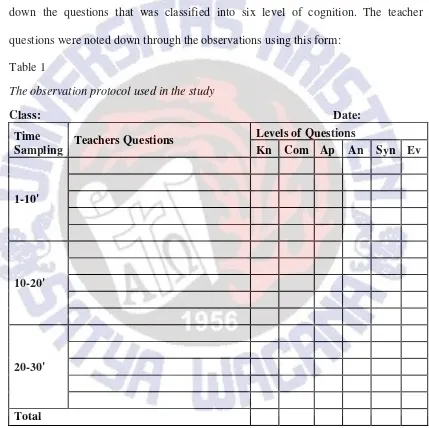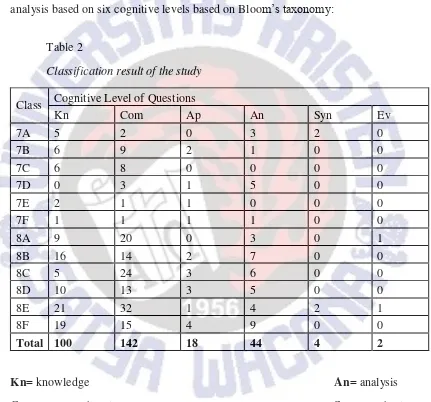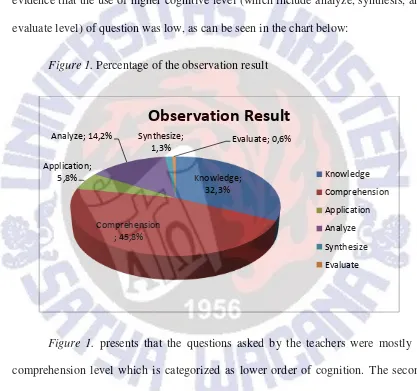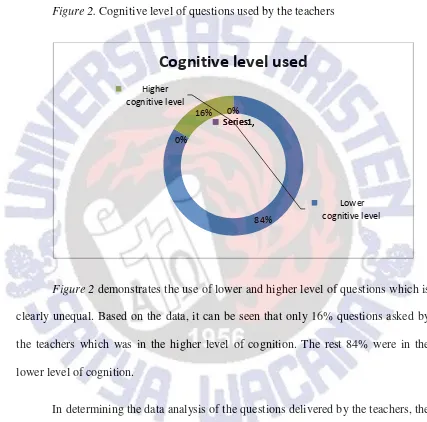1 An Analysis on the Cognitive Level
of Teacher Questions in EFL Classroom of Junior High School in Semarang Residence
DesiAriani
Abstract
To help students achieve their optimum learning, teachers should apply questioning strategies in their classroom. One of questioning strategy which can be applied is related to various cognitive levels of questions. However, seeing teachers teaching during my teaching practicum in a junior high school in Banyubiru, I noticed that some teachers did not really optimize the questioning practice. This study aims to explore cognitive levels of questions used by three EFL teachers in junior high school in Banyubiru. They taught seventh and eighth grade students. In this study, observation was used to collect the data. The data were teachers’ questions, which were classified into six levels of cognition based on Bloom’s taxonomy. The result of this study shows that the teachers used various cognitive levels of questions, but they mostly used comprehension level questions which are in the lower order of cognition. This study can be useful for teachers to be aware of various cognitive levels of questions and apply in the classroom in order to help students to optimize their learning.
Keywords: questioning, cognition, level of question, Bloom’ taxonomy, higher order, lower order
Introduction
It is really important for teachers to use the best teaching technique to make a good teaching. One of the teaching techniques that we really need to pay attention is the practice of questioning as it helps teachers to gain students’ responses and
2 teachers ask question or gather students’ responses about certain topic, the teachers
actually let the students get the important information. Therefore, questioning can create positive impact.
As the other important benefit, Weimer (2011) also stated that questioning can provide feedback. When teacher ask questions, the students will think and are demanded to respond. When students try to respond, teachers can see how far the students understand the lesson and teacher can correct or help the students to correct their mistakes or something they have not really understood (Weimer, 2011). Therefore, by asking questions, teachers can oversee students’ comprehension and
stimulate students’ cognitive developments, especially if teacher can optimize their questioning technique during teaching-learning process.
According to Pearson Education entitled Questioning Strategy Chapter 9, teachers usually use question for many reasons, such as to get students’ interests, checking understanding, and recalling students’ previous lesson. Fattahi (2013)
claimed that questioning should help students develop their creativity and thinking skill by relating the material and applying the concepts to the real world, not only for assessing student’s comprehension. Therefore, to give positive impact in students’ learning, it’s important for teachers to know the hierarchy of the lower to the higher
3 The most well known hierarchy of cognitive level of questions was authored by Bloom in 1956 and is best known as Bloom's Taxonomy. The hierarchy is classified from the lowest to the highest order of cognition.
There were some previous studies on analysis of the cognitive level of questions conducted by some researcher such as Davis (1969), Huenecke (1970), and Khorsand (2009). The result of all the studies showed that the most question level used by teachers was lower order of cognition.
The result of the studies was very similar to my experience. When I was in junior high school, my English teacher always used lower level question such as
“Do you know Tangkuban Perahu?”, while actually the higher level of question
like “How if the Prince did not married the Princess?” can help students to have more creative thinking. There is a gap between the theory about higher level of question with the result of previous studies and also my own experiences as an EFL learner, that indicate the more frequently use of lower level of question. Examining teachers question is important since the use of higher level of question can help students to improve their thinking skill.
For this reason, I conducted a research on an analysis on the cognitive level of teachers’ question used in a junior high school in Banyubiru. I chose the school
4 teachers’ teaching and I saw that the teachers did not really optimize the practice of
questioning.
Understanding the cognitive levels of questions used by the teachers, this study can be beneficial for teachers as reference to make them aware of various cognitive levels of question and apply it in teaching-learning process to give positive impact on students learning.
5 Theoretical Framework
This part will discuss the theories about question, cognitive level of question, as well as result of previous related studies.
Question
Question is any statement that contains interrogative form or function (Cotton, 2001). In classroom, questions are defined as “instructional cues or stimuli that convey to students the content elements to be learned and directions for what they are to do and how they are to do it.” (Cotton, 2001).
In a teaching – learning process, there will be many questions delivered. Richard (1996) listed some reasons why teachers use questions, those are to:stimulate and maintain students’ interest, encourage students to think and focus on the content
of the lesson, clarify what had said by their student, elicit particular structures or vocabulary items, check students’ understanding, encourage student to participate in a
lesson. (p.185)
In addition, Cotton (2001) mentioned the variety of purposes of questioning, those are to: develop interest and motivate students to become actively involved in lessons, evaluate students’ preparation and check on homework or seatwork completion, develop
6 nurture insights by exposing new relationships, assess achievement of instructional goals and
objectives, stimulate students to pursue knowledge on their own
Levels of questions
There are six level of cognition (thinking) of questions based on Bloom’s
Taxonomy. The first hierarchy, which is the lowest level of cognition, is knowledge. This level required the students to recall information they have. E.g. What is the capital city of Indonesia?
The second level is comprehension that asks the students to understand the meaning or combine the data or information they get. E.g. What is the main idea of the first paragraph?
The third level is application which required the students to apply the knowledge in the new situation. E.g. If you want to retell something happened, what tense should you use?
The forth level is analysis which is in higher order of cognition. In this level, teacher will ask the students to analyze to identify reasons, causes, or motives and reach conclusions or generalizations. E.g. Why did the writer go to the hospital?
7 The highest level of questions is evaluation which asks the students to judge the value of ideas. E.g. What’s wrong with his attitude in the story?
The use of cognitive level of teacher’s question
Previously, there were similar researches about questioning level. One of them was conducted by Khan and Inamullah (2011). The result showed that questioning always appears almost in every lesson. The majority level of questioning which appeared was lower level - knowledge, comprehension, and application.
Other researcher, Igbaria (2013) had similar finding on his research on the analysis of the level of questions based on the six levels of the cognitive domain of Bloom’s Taxonomy in the Textbook Horizons (2013). The result showed that the
level of questions mostly appearedwas the comprehension level which is lower cognitive level. Only about 36% questions were in higher order of cognition. In this research, the data was analyzed similarly.
The Study
Context of the study
8 and I want to contribute into this school since I had had my teaching practicum there. During my observation on the teachers’ teaching process in this school, I saw that
some teachers did not make use of questions to optimize the teaching-learning process. Hence, I am interested in analyzing the teachers’ questions, relating to the theory of Bloom’s taxonomy. By this research, it can be known how the use of lower
and higher cognitive level of questions used by teachers.
Participants
The participants were three EFL teachers of junior high school in Banyubiru. Initially, I would involve all the teachers in the school, but because the ninth grade had to focus on national examination, I had to exclude teacher teaching ninth grade and the observation can only be done in seventh and eighth grade, which were taught by the three teachers. The three teachers who participate in this study had related education background and graduated from English education program. They have been teaching English for several years. In the classroom, not all teachers used questioning intensively. One of them used teacher-centered technique in teaching English. Therefore, the teacher asked very limited number of questions.
Instrument of data collection
9 explained different purposes of observation protocol. Since the frequency of questioning occurrence was not the major concern of this study, as the concern was on questions delivered by the teachers, time-sampling protocol was used to note down the questions that was classified into six level of cognition. The teacher questions were noted down through the observations using this form:
Table 1
The observation protocol used in the study
10 Data collection procedure
There were several steps have been done in the data collection. First, deciding the participants of the research and ask for permission to the school principal, who also participated in this study to conduct observations in English class. Second, arranging observation schedule based on the teachers time and the English class schedule. The last, observing was done twelve times in twelve different classes. Each observation took around 20-40-minute long. The teacher questions were noted down to answer the research question.
Data analysis procedures
After the data was collected, the following steps were taken to analyze the data: first, classifying the teachers’ questions into six level of cognition based on Bloom’s taxonomy, which are knowledge, comprehension, application, analysis,
11 Findings and Discussion
From twelve observations in twelve different classes, there were 310 questions which were asked by the three teachers. Below is the data of the questions analysis based on six cognitive levels based on Bloom’s taxonomy:
Table 2
Classification result of the study
Class Cognitive Level of Questions
12 The above table indicated that the most frequently questions employed were at the lower cognitive level which was “comprehension”. While the questions at the highest cognitive level which is “evaluate” only appeared twice. This study provides
evidence that the use of higher cognitive level (which include analyze, synthesis, and evaluate level) of question was low, as can be seen in the chart below:
Figure 1. Percentage of the observation result
Figure 1. presents that the questions asked by the teachers were mostly in
comprehension level which is categorized as lower order of cognition. The second frequently used was knowledge level. The evaluate level which is the highest level was the most rarely used. Among 310 questions 32,3% were knowledge level, 45,8% were comprehension, 5,8% were application, 14,2% were analyze, 1,3% were synthesize, and only 0,6% were evaluate level.
13 Figure below shows the exactly different number of the use between lower and higher level of cognition:
Figure 2. Cognitive level of questions used by the teachers
Figure 2 demonstrates the use of lower and higher level of questions which is
clearly unequal. Based on the data, it can be seen that only 16% questions asked by the teachers which was in the higher level of cognition. The rest 84% were in the lower level of cognition.
In determining the data analysis of the questions delivered by the teachers, the questions were classified from the lowest to the highest cognitive order as below:
Lower cognitive level Series1,
Higher cognitive level
Series1,
84% 0%
16% 0%
14 1. Knowledge
In the cognitive domain, “knowledge” represents the lowest level of
questions. To answer the questions, students are only required to remember their previous knowledge. Common question asked by the teachers in this study is “Do you still remember…. ?” which indicate a recalling material.This kind of question is classified in this level because it only recalls the students’
previous learned material. A further example of questions in knowledge level is in the 5th observation which talked about a narrative text, the legend of Lake Toba:
Do you know who is the character of the story? (5th observation, 21st of February)
To answer this question, the students only had to look back and listed the characters in the story.
Interestingly, some questions can be classified into more than one level. For example
What is the purpose? (8th observation, 26th of March)
What is the purpose of narrative text? (1st observation, 8th of February)
15 text which was someone’s experience, in the first observation they talked
about narrative text which was about little mermaid. In this case, they had discussed recount and narrative texts in the previous meeting. The sample questions above could be classified as analysis level. However, since the purpose of the teacher was only for recalling the students about the purpose of recount and narrative text, which had been discussed before, this question was classified into knowledge level.
In my experiences it was also proven that teacher often ask this kind of question to remind the students about the purpose of different kinds of text. E.g. narrative text is purposed to entertain the readers, descriptive text is purposed to describe things or people, and so on.
Another example can be seen from 5th observation, 21st of February, 2014:
What is in the orientation?
In orientation, what can you find? (5th observation, 21st of February)
In this case, the lesson about orientation had been taught in previous meeting. Thus, these two questions were classified into knowledge level as the students were asked to recall the material they had learned in the previous meeting.
16 purpose of using this level based on Cotton (2001) listed is to review and summarize previous lesson. Another purpose is probably to encourage students’ participation in a lesson (Richard, 1996) as can be seen from this
question:
Anyone knows what letter is? (11th observation, 23th of April)
The topic of the lesson in the 11th observation was about letter in 8th grade. By the question above, the students were engaged to give response.
2. Comprehension
In the comprehension level students are required to understand a context by explaining or summarizing, stating ideas and retell a context using their own words. E.g.
What is the first paragraph about? (5thobservation, 21th of February)
In that particular context, students should understand the text, and then answer the question using their own words.
Another sample question can be seen as in this example:
17 The question was classified into comprehension level because the students are required to summarize or conclude about what orientation is, which had been talked before.
As for the possible reason of questions at this level is probably to encourage students to think and focus on the content of the lesson (Richard, 1996). E.g.
What should be there? (11th Observation, 23rd of April)
In the 11th observation, teacher and eighth-grade students were talking about letter which is recount text. The students would be directed to comprehend and focus on the content of the passage given by the teacher which was the letter. Another possibility of using this level was to elicit particular vocabulary as can be seen from this example:
‘furious' itu apa? ‘ran home' apa? what is 'promise'? what is 'huge disaster'? what is 'disaster'? 'Huge'?
‘nonstop’ ki opo? What is ‘nonstop’? (12th observation 26th of April)
18 were asked to elicit vocabulary to translate and understand the meaning of the sentence in the passage. Meanwhile, another possible reason for using the comprehension question was to encourage students to participate in a lesson, as in the example below:
Will you say something about formal letter? (11th Observation, 23rd of April)
3. Application
Application has higher intellectual level than comprehension level. Here students are asked to apply the lesson into a new situation or real world. E.g.
What lesson can you get from the story? (5th observation, 21st of
February)
Another example is appeared in 9th observation which talked about recount text:
Use –ed or not? (27th of March)
Student should apply the best form of tenses. The sample question above can be asked to elicit particular structure.
Other example which required students to apply the lesson into real world is:
19 The students were asked about something related to real world in the classroom. Thus, this kind of question was classified into application level.
Another example was quite interesting since it can be both knowledge and application level as the example in 7th observation in 7th grade below:
‘making' terbentuk dari kata kerja?(7th observation, 19th of March) Begin-beginning, contoh lainnya apa? (7th observation, 19th of March)
The second term was considered as application level because previously teacher had talked about the form-making using –ing. Then students were required to apply the theory of –ing form in a new situation, not only recalling previous lesson.
Therefore, it can be seen that the occurrence of questions in this level is very little. This maybe because it is quite difficult since in application level question, the student should apply the theory of the lesson into a new context of lesson. From the sample questions, eliciting particular structure is the most possible reason of teachers using this level of question. E.g.
Was or were? (9th observation, 27th of March) Use –s or not? (8th observation, 26th of March)
4. Analysis
20 What kind of story is that? (1st observation, 8th of February)
Is it happy ending? Why? (5th observation, 21th of February)
In the examples, students were asked to analyze the kind of story and give reason why the story was happy ending or not. The purpose of teachers using this level can be for developing students’ critical thinking skills and inquiring attitudes since the students should analyze with their own reason.
5. Synthesis
In this level students were invited to give ideas, create something new, and were encouraged to have creative thinking. They also can develop previous ideas with their new thought. E.g.
Do you know, can you guess what is the last wish? (5th observation, 21st February)
To answer this question, students will give their new ideas.
There are only 4 questions in this level. The level of application places at the second lowest order of questions mostly used by teachers.
21 6. Evaluation
In the evaluation level, students were required to judge the value of material and give solution of a problem. This level has the highest cognitive order since the students have to give judgment after understanding context of the material after using the previous lower cognitive level of questions. E.g.
Is it a good story? (5th observation, 21th of February)
To answer this question, students were required to judge whether the story is good or not, and provide the reason.
The reasons of using this level may be to stimulate students’ critical
22 Conclusion
This study is conducted to answer the research question: What are the cognitive levels of teachers’ question used by the English teachers in a junior high
school inBanyubiru?” From the twelve observations in twelve different classes of seventh and eighth grade in a junior high school in Banyubiru, it can be concluded that the teachers used all variation level of questions based on Bloom’s taxonomy,
but comprehension level was mostly used.
Theoretically, higher cognition (include analyzing, synthesis, and evaluative level) provide critical thinking skill. Question is usually used to assess students’
understanding, but more than that, teacher should also use variation of question to help students extend their thinking and also stimulate them to have creative thinking. Higher level of question can help students to increase their thinking skill and creativity. Meanwhile, the finding of this study shows that teachers did not explore higher level of questions. However, the finding can be related to the reasons of questioning. Hence, there are some probable reasons of using certain level of questions.
This study focused on what cognitive level of questions used by the teachers. Unfortunately, by using observation, this study cannot provide the real reasons of employing certain level of question from the teachers. Therefore, it will be interesting if a further research could assess the teacher’s reason of using certain
24 Acknowledgement
25 References
Bloom. B. S. (Ed.). (1964). Taxonomy of Educational Objectives. Handbook I: The cognitive domain. Longman Inc.
Cotton. K. (1988). Classroom Questioning. Northwest Regional Educational Laboratory.
Critelli. A., Tritapoe. B. (2010). Effective Questioning Techniques to Increase Class Participation. E-Journal of Student Research. Vol. 1, 2.
Dunkin. M. J., Biddle. B. J. (1974). The Study of Teaching. United States: Holt, Rinehart and Winston Inc.
Fries-Gaither. J. (2008). Questioning Techniques: Research-Based Strategy for Teachers. The Ohio State University.
Kessler. C. (1992). Cooperative Language Learning. Englewood Cliffs: Prentice-Hall Inc.
Khan. W. B., Inamullah. H. M. (2011). A Study of Lower-order and Higher-order Questions at Secondary Level. Canadian Center of Science and Education. Vol. 7, No. 9.
Krathwohl. D.R., Bloom. B.S., Masia. B.B. (1964). Taxonomy of educational objectives.Handbook II: The affective domain. Longman Inc.
McCafferty. S. g., Jacobs. G. M., Iddings. A. C. D. (2006). Cooperative Learning and Second Language Teaching. New York: Cambridge University Press.
McComas. W. F., Abraham. L. (n.d). Asking More Effective Question. Rossier School of Education.
Patterson. N. C., Lucas. A. G., Kithinji. M. (2012). Higher Order Thinking in Social Studies: An Analysis of Primary Source Document Use. Social Studies Research and Practice. Vol. 7. No. 2.
Richard. J. C. (Ed.)., Lockhart. C. (1996). Reflective Teaching in Second Language Classrooms. New York: Cambridge University Press.
26 Pearson Education. Chapter 9: Questioning Strategies. USA: Author.
Pearson Education. Level of Questions in Bloom’s Taxonomy. USA: Author. Retrieved from https://www.teachervision.com/teaching-methods/new-teacher/48445.html?page=2
University of Uregon. (2014) Bloom’s Taxonomy of Cognitive Levels. Author. Retrievedfrom



